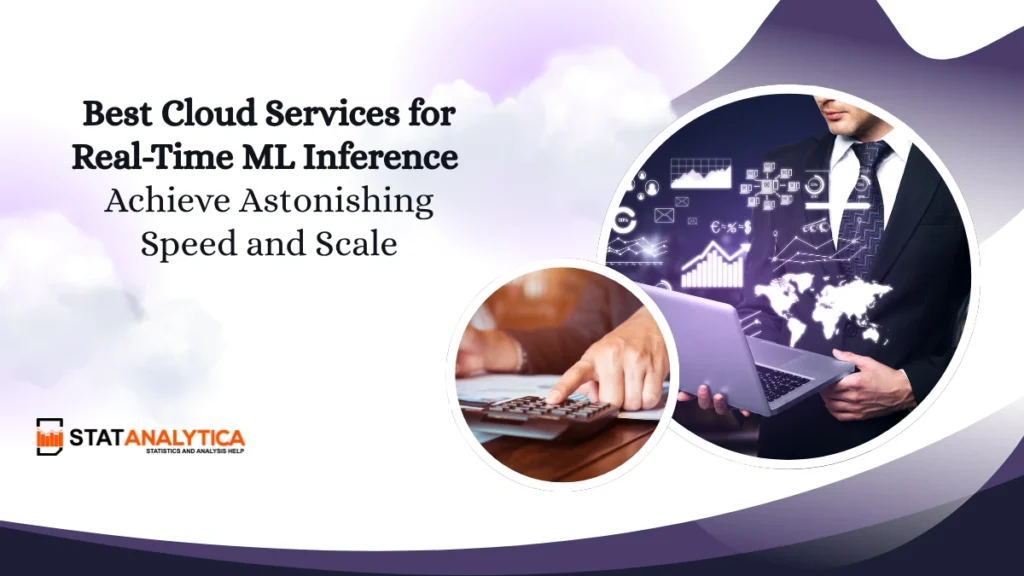The digital world demands instant decisions. From lightning-fast financial fraud detection and hyper-personalized e-commerce recommendations to instantaneous medical diagnostics, the ability to deploy Machine Learning (ML) models that deliver predictions in milliseconds is no longer a luxury—it’s a fundamental competitive necessity.
The backbone of this instant-gratification reality is Cloud Services for real-time ML inference, and the best way to achieve it is by leveraging the phenomenal power of specialized cloud services.
This detailed guide dives deep into the premier cloud platforms, revealing the top-tier solutions, essential features, and expert strategies for building a robust, low-latency MLOps pipeline. Prepare to transform your ML projects from slow, batch processes into dynamic, real-time decision engines!
The Real-Time Revolution: Why Low-Latency ML Deployment is Your Next Big Win
Table of Contents
Real-time Machine Learning refers to the process where a trained ML model receives a request, generates a prediction (inference), and returns the result in near-instantaneous time, often within sub-100 millisecond latency windows.
Beyond the Hype: Core Benefits of Cloud Services for Real-Time ML
Deploying your models using cloud ML services brings massive advantages over on-premises solutions, especially for latency-sensitive applications:
- Astonishing Scalability: Real-time workloads are often unpredictable. Cloud platforms offer automatic scaling (autoscale) to handle sudden spikes in requests without manual intervention, ensuring continuous, high-performance service.
- Ultra-Low Latency: Global infrastructure with strategically placed data centers and specialized hardware (GPUs, TPUs, custom accelerators like Inferentia) allows you to serve predictions physically closer to your users, drastically reducing network latency.
- Fully Managed MLOps: The best cloud services handle the complex, non-differentiating tasks of infrastructure management, container orchestration, logging, and monitoring, allowing your data science team to focus purely on model innovation.
Key Characteristics of a Stellar Real-Time ML Platform
When evaluating the best cloud services for real-time ML, focus on these non-negotiable features:
- High-Performance Endpoints: Dedicated endpoints optimized for low-latency inference.
- Serverless Inference: For pay-per-execution and immediate spin-up/spin-down for event-driven workflows.
- Real-Time Feature Store: A dedicated layer to serve pre-calculated and fresh features with low-latency access, ensuring consistency between training and serving.
- Advanced Monitoring: Tools to track latency percentiles (P95, P99) and detect data drift or model drift instantaneously.
- Multi-Region/Multi-Zone Redundancy: High Availability (HA) to prevent downtime from regional failures, crucial for mission-critical applications like real-time fraud detection.
The Titans of Cloud Services for Real-Time ML Inference: AWS, Google Cloud, and Azure
The cloud landscape is dominated by three giants, each offering a powerful, yet distinct, suite of tools optimized for low-latency ML deployment.
| Feature | AWS SageMaker (Amazon Web Services) | Google Vertex AI (Google Cloud Platform – GCP) | Azure Machine Learning (Microsoft Azure) |
| Core Service | Amazon SageMaker | Google Cloud Vertex AI | Azure Machine Learning |
| Real-Time Inference | SageMaker Real-Time Endpoints | Vertex AI Endpoints | Azure ML Real-time Endpoints |
| Serverless Option | SageMaker Serverless Inference, AWS Lambda | Vertex AI Endpoints (Serverless), Cloud Run | Azure Functions, Azure Container Apps |
| Specialized Hardware | AWS Inferentia (Inf2), Trainium (Trn1) | Google TPUs (Tensor Processing Units) | Azure ND, NC series (NVIDIA GPUs) |
| Feature Store | Amazon SageMaker Feature Store | Vertex AI Feature Store | Azure ML Feature Store (Preview/Generally Available) |
| MLOps Integration | SageMaker Pipelines, SageMaker Studio | Vertex AI Pipelines, Vertex AI Workbench | Azure ML Pipelines, MLflow Integration |
| Best For | Organizations deeply invested in the AWS ecosystem, unparalleled breadth of services. | Cutting-edge ML research, high-performance for TensorFlow/PyTorch, fastest growing platform. | Enterprises in regulated industries, strong integration with Microsoft 365/Dynamics. |
Amazon SageMaker: The Undisputed Market Leader for Scale
AWS SageMaker is the most mature and comprehensive platform. It provides an end-to-end MLOps solution that is particularly robust for large-scale, high-throughput scenarios.
- SageMaker Real-Time Endpoints: Easily deploy models behind secure, highly scalable API endpoints. Crucially, they offer Multi-Model Endpoints, allowing you to host hundreds of models on a single infrastructure stack, significantly improving cost efficiency for micro-models (e.g., personalized recommendations).
- SageMaker Serverless Inference: A game-changing feature for sporadic, low-volume models, where you only pay for the execution time, with near-instantaneous start times that maintain low latency.
- AWS Inferentia: Custom-designed chips to accelerate model inference, offering some of the lowest costs per prediction for models that require a high volume of complex computations.
Google Vertex AI: The Champion of Simplicity and Speed
Google, the pioneer of technologies like TensorFlow, offers Vertex AI as a unified platform designed to simplify the entire ML lifecycle—especially moving from experimentation to production.
- Unified MLOps Experience: Vertex AI unifies all data science services under one intuitive interface, making real-time ML deployment less painful.
- TPU Optimization: For complex models, particularly those involving large language models (LLMs) or deep learning, Google’s TPUs provide unparalleled parallel processing power for ultra-fast, low-latency serving.
- Vertex AI Feature Store: This service is natively integrated and provides a central, highly available, and low-latency serving layer for features, which is essential for ensuring your real-time predictions are based on the freshest data possible.
Azure Machine Learning: The Enterprise Integration Powerhouse
Azure ML is often the preferred choice for large enterprises, especially those already heavily utilizing the Microsoft ecosystem. Its strength lies in governance, security, and enterprise-grade integration.
- Azure Kubernetes Service (AKS) Integration: For containerized, high-volume, and low-latency inference, Azure ML leverages AKS, providing a powerful, standardized orchestration environment.
- Azure Functions for Serverless: Similar to AWS Lambda, Azure Functions provides a robust, event-driven, serverless compute environment for low-latency ML inference on simpler models.
- Regulatory Compliance: Azure shines in regulated industries like finance and healthcare, offering extensive security and compliance certifications (e.g., HIPAA, FedRAMP).
The Crucial Role of MLOps in Achieving Astonishingly Fast Inference
Achieving and maintaining low latency and high throughput in production requires more than just a model and an endpoint; it requires mature MLOps practices. MLOps bridges the gap between development and operations for machine learning systems.
Key Components of a High-Performance MLOps Pipeline
- Feature Consistency (Feature Store):
- The Problem: The features used for training a model often differ from those used for real-time inference, leading to training-serving skew and poor performance.
- The Solution: Use a dedicated real-time feature store (like SageMaker, Vertex AI, or Feast) to ensure the exact same features are served instantly in production as were calculated during training.
- Model Optimization for Speed:
- Techniques: Before deployment, techniques like Quantization (reducing the precision of weights from 32-bit to 8-bit floats) and Pruning (removing unnecessary connections) can drastically reduce model size and inference time without significant loss of accuracy.
- Specialized Servers: Utilizing optimized serving software like NVIDIA Triton Inference Server or TensorFlow Serving can dramatically improve throughput and reduce latency.
- Continuous Monitoring and Feedback Loops:
- Real-Time Alerts: Set up alerts for critical metrics like P99 latency and data drift (when incoming data deviates from training data).
- Automated Retraining: When a model’s performance degrades (model drift) or drift is detected, the pipeline should automatically trigger a model retraining job and seamlessly deploy the new, optimized version. This creates a perpetually improving system.
Expert Strategies for Cost Optimization in Cloud ML Services
While real-time ML is a powerful accelerator for business value, it can become expensive if not managed carefully. The goal is to maximize prediction speed while minimizing unnecessary expenditure.
Brilliant Ways to Reduce Your Real-Time ML Bill
- Right-Sizing Compute Instances: Avoid the temptation to over-provision. Monitor your CPU and memory utilization (especially P95 metrics) and adjust your instance type or size accordingly. Use smaller, specialized inference-optimized instances.
- Leverage Serverless and Autoscaling: For variable traffic, serverless endpoints (like SageMaker Serverless Inference or Azure Functions) or aggressive autoscaling policies are your best friend. They scale down to zero (or near-zero) during off-peak hours, cutting costs dramatically.
- Reserved Instances (RI) / Committed Use Discounts (CUD): If you have a predictable, high-volume baseline load, commit to 1- or 3-year Reserved Instances (AWS/Azure) or Committed Use Discounts (GCP) for significant savings (often 40-70%).
- Multi-Model Endpoints: As highlighted with SageMaker, hosting multiple smaller models on a single endpoint dramatically increases resource utilization, translating directly into amazing cost savings.
The Future is Now: Generative AI and Real-Time Inference
The recent explosion of Generative AI (GenAI) and Large Language Models (LLMs) is redefining real-time ML. Services like AWS Bedrock, Google Vertex AI (with Gemini models), and Azure OpenAI Service are now offering managed services for low-latency serving of these massive foundation models.
- Low-Latency LLM Serving: Cloud providers are deploying specialized hardware and optimized container images to serve massive LLMs with high throughput and low latency, enabling instantaneous AI-driven conversations and content generation.
- RAG for Real-Time Search: Retrieval-Augmented Generation (RAG) applications require real-time data ingestion and instant retrieval of context before LLM inference. The performance of your cloud data streaming (e.g., Kafka on Confluent, AWS Kinesis, or Google Pub/Sub) and vector database will be key to low-latency RAG systems.
Conclusion: Your Path to Unstoppable Real-Time ML Success
The selection of the best cloud services for real-time ML is a strategic decision that depends on your existing tech stack, latency requirements, and the complexity of your models.
Whether you choose the unparalleled scale of AWS SageMaker, the streamlined speed of Google Vertex AI, or the enterprise-grade compliance of Azure Machine Learning, the core principles remain the same: prioritize low-latency MLOps, utilize a high-performance feature store, and implement smart cost optimization.
By embracing these powerful cloud solutions, you are not just making predictions—you are delivering instantaneous, business-critical intelligence that will accelerate your company’s growth and put you miles ahead of the competition. The time to unlock your model’s astonishing speed is now!
Also Read: PyTorch for Machine Learning: Unleashing the Power


